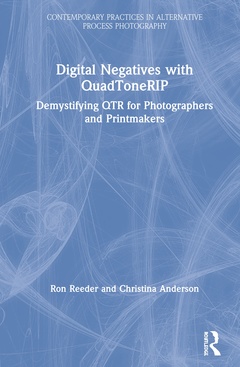Digital Negatives with QuadToneRIP Demystifying QTR for Photographers and Printmakers Contemporary Practices in Alternative Process Photography Series
Auteurs : Reeder Ron, Anderson Christina

Digital Negatives with QuadToneRIP is a text that fully explores how the QuadToneRIP printer driver can be used to make expert digital negatives. The book takes a comprehensive, Òunder-the-hoodÓ look at how Roy Harrington?s QTR printer driver can be adapted for use by artists in several different creative practice areas. The text is written from the Mac/Photoshop point of view.
The book is divided into three parts. Part One is a step-by-step how-to section that will appeal to both beginning and more advanced practitioners. Part One includes quickstart guides or summary sheets for beginning students who want to jump into using QTR before understanding all of its functional components. Part Two addresses dimroom, darkroom, and printmaking practices, walking the reader through brief workflows from negative to print for lithium palladium, gum bichromate, cyanotype, salted paper, kallitype, silver gelatin and polymer photogravure, with a sample profile for each. It also includes an introduction to a new software iteration of QTR: QuickCurve-DN (QCDN). Part Three is devoted to contemporary practitioners who explain how they use QTR in their creative practice.
The book includes:
- A list of supplies and software needed
- A summary QTR glossary with a simple explanation of how each function works
- A sample walk-through to create a QTR profile from start to finish
- How to linearize profiles with simple to more exacting tools
- A visual guide to modifying functions
- Quickstart guides for many of the workflows
- Instructions for crafting monochrome, duotone, tricolor, and quadcolor negatives
- Instructions for using QTR to print silver gelatin in the darkroom
- Instructions for using QTR to print alternative processes in the dimroom
- Instructions for using QTR to print polymer photogravure in the printmaking room
- Introductory chapter to QuickCurve-DN software
- Troubleshooting common QTR problems
- Generic starter profiles for processes discussed
- Contemporary artists: their work and QTR process.
Learning how to craft expert digital negatives can be a bit overwhelming at the outset. Digital Negatives with QuadToneRIP makes the process as user-friendly as possible. Like other books in the series, Digital Negatives with QuadToneRIP is thoroughly comprehensive, accessible to different levels of learner, and illustrative of the contemporary arts.
Preface, Biography, Foreword, Part I: QuadToneRIP 1. Getting Started, 2. Supplies, 3. Overview of QTR Vocabulary, 4. A Sample QTR Workflow, 5. Linearizing a Profile, 6. A Visual Guide to Profile Functions, 7. Quickstart Guides, 8.Troubleshooting QTR, Part II: Sample Workflows from Negative to Print, 9. Silver Gelatin by Doug Ethridge, 10. Lithium Palladium, 11. Gum Bichromate, 12.Cyanotype, 12. Salted Paper, 14. Kallitype by Don Nelson, 15. Polymer Photogravure by Clay Harmon, 16. QuickCurve-DN by Richard Boutwell, Part III: Contemporary Artists, 17. Contemporary Artists, Harlan H. Chapman, Martha E. Davis, David J. Eisenlord, Douglas Ethridge, Kate Jordahl, Sandy King, Michael Puff, Judith Roan, Michael P. Rosenberg, Keith Schreiber, Bill Schwab, Mark Severson, John Foxe Sheets, Ryan Stander, Sam Wang, Jeanne Wells, Tom Wise, Rebecca Zeiss, Appendix, Bibliography, Index
Dr. Ron Reeder (1939–2019) was a research molecular biologist, retiring in 2002 from the Fred Hutchinson Cancer Research Center in Seattle at which time he devoted himself to a second career in photography. Reeder’s particular interest was landscape photography. In addition, he relished taking wildlife, portraiture, and still life. Reeder was the first to apply Roy Harrington’s QuadToneRIP software to the making of digital negatives and went on to author books on the subject. This book is Reeder’s third on the technology of making digital negatives using QTR and is a testament to his role as mentor of the photographers included in its pages.
Christina Z. Anderson’s work focuses on the contemporary vanitas printed in a variety of 19th century photographic processes, primarily gum and casein bichromate, salted paper, cyanotype, and palladium. Anderson’s work has shown internationally in over 100 shows and 50 publications. This is her sixth book on alternative processes. Anderson is Series Editor for the Contemporary Practices in Alternative Process Photography series and Professor of Photography at Montana State University. To see more of her work, visit christinaZanderson.com.
Date de parution : 10-2020
20.3x25.4 cm
Date de parution : 10-2020
20.3x25.4 cm
Thèmes de Digital Negatives with QuadToneRIP :
Mots-clés :
DIGITAL NEGATIVES; Exposure Time; Photography; Step Wedge; Printing; Palladium Print; Christina Anderson; Gray Gamma; Ron Reeder; Gray Curve; Roy Harrington; Ink Limit; Gum; Step Tablet; Salted Paper; Txt File; Cyanotype; Gelatin; Correction Curve; Palladium; Gum Layer; Alternative Processes; HPR; Quad Tone RIP; Ferric Oxalate; QTR; Silver Gelatin Print; Blocking Density; Printmaking; Hash Tag; QTR glossary; Light Inks; Printer driver; Arches Platine; QuickCurve-DN software; Platinum Rag; Ammonium Dichromate; Dark Inks; Disodium EDTA; Starter Curve; Vacuum Frame



